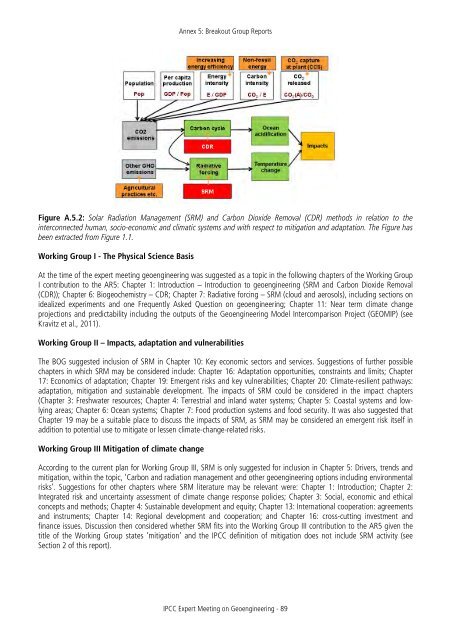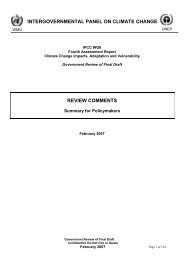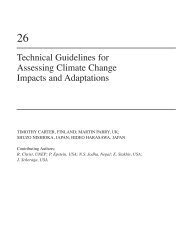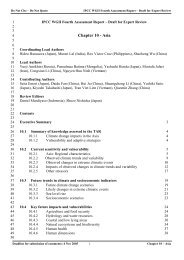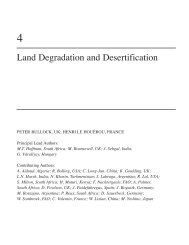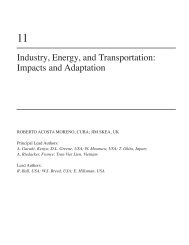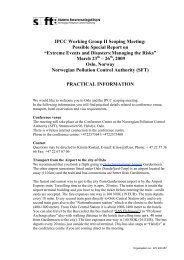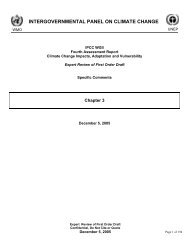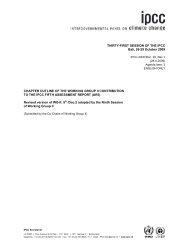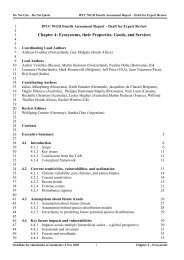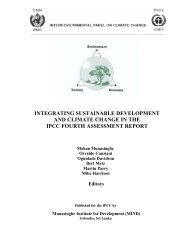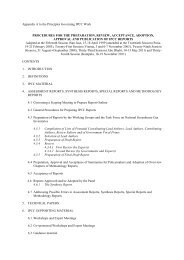IPCC Expert Meeting on Geoengineering
IPCC Expert Meeting on Geoengineering
IPCC Expert Meeting on Geoengineering
You also want an ePaper? Increase the reach of your titles
YUMPU automatically turns print PDFs into web optimized ePapers that Google loves.
Annex 5: Breakout Group Reports<br />
Figure A.5.2: Solar Radiati<strong>on</strong> Management (SRM) and Carb<strong>on</strong> Dioxide Removal (CDR) methods in relati<strong>on</strong> to the<br />
interc<strong>on</strong>nected human, socio-ec<strong>on</strong>omic and climatic systems and with respect to mitigati<strong>on</strong> and adaptati<strong>on</strong>. The Figure has<br />
been extracted from Figure 1.1.<br />
Working Group I - The Physical Science Basis<br />
At the time of the expert meeting geoengineering was suggested as a topic in the following chapters of the Working Group<br />
I c<strong>on</strong>tributi<strong>on</strong> to the AR5: Chapter 1: Introducti<strong>on</strong> – Introducti<strong>on</strong> to geoengineering (SRM and Carb<strong>on</strong> Dioxide Removal<br />
(CDR)); Chapter 6: Biogeochemistry – CDR; Chapter 7: Radiative forcing – SRM (cloud and aerosols), including secti<strong>on</strong>s <strong>on</strong><br />
idealized experiments and <strong>on</strong>e Frequently Asked Questi<strong>on</strong> <strong>on</strong> geoengineering; Chapter 11: Near term climate change<br />
projecti<strong>on</strong>s and predictability including the outputs of the <strong>Geoengineering</strong> Model Intercomparis<strong>on</strong> Project (GEOMIP) (see<br />
Kravitz et al., 2011).<br />
Working Group II – Impacts, adaptati<strong>on</strong> and vulnerabilities<br />
The BOG suggested inclusi<strong>on</strong> of SRM in Chapter 10: Key ec<strong>on</strong>omic sectors and services. Suggesti<strong>on</strong>s of further possible<br />
chapters in which SRM may be c<strong>on</strong>sidered include: Chapter 16: Adaptati<strong>on</strong> opportunities, c<strong>on</strong>straints and limits; Chapter<br />
17: Ec<strong>on</strong>omics of adaptati<strong>on</strong>; Chapter 19: Emergent risks and key vulnerabilities; Chapter 20: Climate-resilient pathways:<br />
adaptati<strong>on</strong>, mitigati<strong>on</strong> and sustainable development. The impacts of SRM could be c<strong>on</strong>sidered in the impact chapters<br />
(Chapter 3: Freshwater resources; Chapter 4: Terrestrial and inland water systems; Chapter 5: Coastal systems and lowlying<br />
areas; Chapter 6: Ocean systems; Chapter 7: Food producti<strong>on</strong> systems and food security. It was also suggested that<br />
Chapter 19 may be a suitable place to discuss the impacts of SRM, as SRM may be c<strong>on</strong>sidered an emergent risk itself in<br />
additi<strong>on</strong> to potential use to mitigate or lessen climate-change-related risks.<br />
Working Group III Mitigati<strong>on</strong> of climate change<br />
According to the current plan for Working Group III, SRM is <strong>on</strong>ly suggested for inclusi<strong>on</strong> in Chapter 5: Drivers, trends and<br />
mitigati<strong>on</strong>, within the topic, ‘Carb<strong>on</strong> and radiati<strong>on</strong> management and other geoengineering opti<strong>on</strong>s including envir<strong>on</strong>mental<br />
risks’. Suggesti<strong>on</strong>s for other chapters where SRM literature may be relevant were: Chapter 1: Introducti<strong>on</strong>; Chapter 2:<br />
Integrated risk and uncertainty assessment of climate change resp<strong>on</strong>se policies; Chapter 3: Social, ec<strong>on</strong>omic and ethical<br />
c<strong>on</strong>cepts and methods; Chapter 4: Sustainable development and equity; Chapter 13: Internati<strong>on</strong>al cooperati<strong>on</strong>: agreements<br />
and instruments; Chapter 14: Regi<strong>on</strong>al development and cooperati<strong>on</strong>; and Chapter 16: cross-cutting investment and<br />
finance issues. Discussi<strong>on</strong> then c<strong>on</strong>sidered whether SRM fits into the Working Group III c<strong>on</strong>tributi<strong>on</strong> to the AR5 given the<br />
title of the Working Group states ‘mitigati<strong>on</strong>’ and the <str<strong>on</strong>g>IPCC</str<strong>on</strong>g> definiti<strong>on</strong> of mitigati<strong>on</strong> does not include SRM activity (see<br />
Secti<strong>on</strong> 2 of this report).<br />
<str<strong>on</strong>g>IPCC</str<strong>on</strong>g> <str<strong>on</strong>g>Expert</str<strong>on</strong>g> <str<strong>on</strong>g>Meeting</str<strong>on</strong>g> <strong>on</strong> <strong>Geoengineering</strong> - 89


